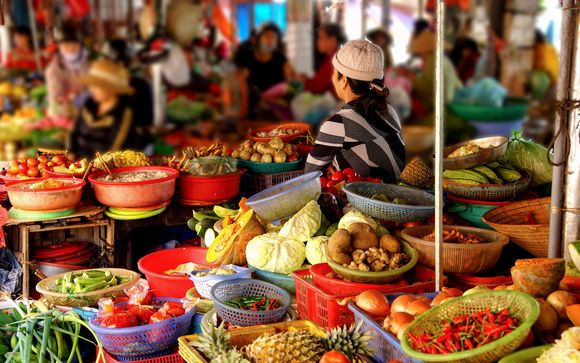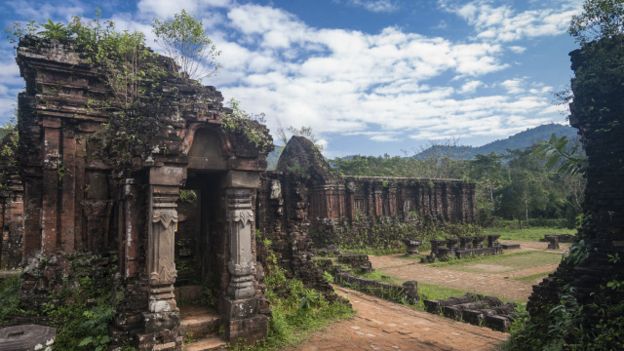Mr Quang and I were doing some spying, deep inside central Vietnam. Our mission? To discover the top-secret ingredient of cao lau from a family of fourth-generation noodle-makers, who’ve been making it for 150 years. Possessing a moreish smoky taste and a chewy texture, the exact recipe of Hoi An’s unique dish is shared among only four families who jealously guard the recipe.
Amid the lime-green paddy fields surrounding Hoi An, Mr Quang guided me to the Ta family’s courtyard, where raffia platters of these earthworm-like noodles were drying in the sun. Mrs Ta saw us arrive and had sharp words for Quang. “She’s suspicious of you, she thinks you’ve come to steal their secrets,” he translated.
Mr Ta was more accommodating, and cheerfully explained some of the processes involved in making cao lau. It is common knowledge that the rice used should be boiled in spring-water drawn from Hoi An’s revered Ba Le well and then steamed in a metal cauldron at 180°C over a gum-tree wood fire.

But he was less forthcoming when it came to the secret ingredient that gives the noodles their unique texture; angling for a scoop, I asked what this might be… “No, no, no,” admonished a smiling Mr Ta, “I cannot tell you that.”
There are no such secrets, however, about the exotic recipe that makes Hoi An a firm travellers’ favourite in South-East Asia – indeed, you, the readers of Wanderlust, have just voted it your ‘Top City’.
A visit to this beguiling river port quickly reveals why it’s heading many a traveller’s to-do list: it has the most complete ancient centre in Vietnam, great shopping and cuisine, and golden sandy beaches close to hand.
Legacy of layers
If anything, on first impressions Hoi An may seem a little too touristy – almost every ancient building is given over to a hotel, restaurant, bar, tour operator or souvenir shop. Yet this new trade doesn’t in the least contradict its legacy of enticing outsiders.
Foreign traders have been arriving in Hoi An for over 1,000 years, accessing it from the South China Sea via the Thu Bon River. Over time it became one of Asia’s most important trading ports, initially under the auspices of the Champa kingdom and later under their vanquishers, the Vietnamese. During its halcyon days, between the 16th and 19th centuries, traders from Japan, Europe and China came seeking silk, precious metals, gems and tea.

In return they imprinted a distinct architectural and cultural overlay, witnessed today in eclectic reminders of cosmopolitanism: Japanese arched bridges, French wooden shutters and Chinese pagodas, juxtaposed against sagging circular-tiled roofs and mustard-yellow adobe walls that smoulder at sunset.
Ironically the architectural intactness of Hoi An’s densely packed merchant townhouses survives because of the town’s rapid demise. When the Thu Bon River silted up in the 19th century, the trade ships stopped arriving and economic stagnation preserved it as if in aspic. Now, the modern-day trade is tourism, which has revived the fortunes of this UNESCO World Heritage-listed town.
Arriving by taxi from Danang Airport, 35km away, I entered the ancient quarter’s narrow lanes on foot. Cars are banned from the centre – a merciful relief after Hanoi and Saigon, where crossing the road is akin to Russian roulette.

My hotel, Vinh Hung 1, was a historic treasure itself. At 200 years old, it’s one of Hoi An’s most graceful Chinese merchant’s houses, furnished head-to-toe in polished mahogany, from its lofty ceilings to its creaky floorboards. The six spacious rooms are arranged around an atrium courtyard to the rear, while huge shuttered windows allow morning rays to illuminate a breakfast buffet of fried noodles, dim sum dumplings and speckled dragonfruit.
Living history
After breakfast, Nguyen Tuyet Linh breezed by to begin our guided tour of Hoi An’s historic landmarks. Petite and dressed entirely in pink, she shivered as she told me, without irony, “we can’t bear the cold when temperatures fall to around 18-19°C.”
She explained the greatest architectural influence on Hoi An had come from Chinese merchants, from whom many Hoianese families trace their ancestry today. The most overt expression of this are the community’s assembly halls, still used by the offspring of different Chinese ethnic groups such as the Cantonese.
Most eye-catching is the 17th-century Fujian Assembly Hall – a strikingly kitsch compound of triple-arched gateways, feng shui gardens and a dragon-topped Taoist shrine. Like every other town property it’s richly frescoed with auspicious symbols: carps for prosperity; peaches for longevity; door-eyes for clear-sightedness; bats for happiness.
Yet for all this photogenic theatricality I quickly appreciated such monuments are not empty husks recalling abandoned traditions; they retain genuine resonance within 21st-century Hoianese beliefs.
I witnessed childless couples seeking spiritual fertilisation by placing betel nut offerings at the shrine of the 12 sacred ba mu(midwives) while fishermen lit incense sticks at the assembly hall’s ex-voto model ship, beseeching Thien Hau, the protective deity of sailors, for safe passage at sea.
Equally, there remains a functionality to Hoi An’s archaic structures. Old Chinese townhouses (best visited around 8am before they fill with tour-parties) are very much lived in by latter generations of the original merchants.
The 230-year-old Phung Hung house is occupied by the seventh and eighth generations of the Tranh clan. Nearby, Hoi An’s most iconic structure, a sensuously arched 16th-century Japanese covered bridge, remains a key crossing point.

This sense of lived-in authenticity was especially noticeable at night: the Hoianese somewhat reclaim the town centre when the hubbub of visitors dies down. Instead, the atmospherically shadowy lanes echo to sounds of whirring sewing machines, family arguments and laughter, and tile-slapping games of Chinese checkers.
Come the evening, most tourists migrate to the banks of the Thu Bon River, the place to promenade as Hoi An undergoes its daily transformation from historic quarter to pleasuredome. Here, myriad restaurants and bars offer never-ending ‘happy hours’ while the buzz of mercantilism dominates: people barter for artworks, crafts and pirated DVDs; tailors whip up shirts and taffeta dresses before you’ve even had time to ask how much. All over, Hoi An twinkles with lanterns of every colour.

I just went with this nightly flow. “Hello, motorboat… one hour” was the repeated refrain of the boatman moored along the riverfront, offering couples romantic nighttime cruises. A little boy in a shiny silver suit danced ‘Gangnam Style’ for tourist dollars. I lost 10,000 dong (OK, 30p) at an open-air game of musical bingo, whose caller belted out traditional Vietnamese folk songs.
I ended up wandering into a handicrafts emporium that keeps silkworms to demonstrate the A to Z of silk-thread spinning. “One cocoon provides 1km of silk,” explained saleswoman Phuong.
C’est magnifique
But it’s Hoi An’s much-vaunted cuisine that proves most tantalising. Some restaurants fuse Western presentation with local recipes but I was seeking more traditional fare so headed inside a cho (market) that was sizzling with aromas. It was here I discovered – and became a bit obsessive about – cao lau. I watched as the vendor rapidly mixed the special noodles with pork slices, fish sauce, beansprouts and fresh herbs, and topped them with wonton croutons. It was love at first bite.
Another evening I dined al fresco at one of Hoi An’s quirkier establishments, Café des Amis on the waterfront. It’s hard to bypass because its Francophone chef, Mr Kim, sits front of house and bellows ‘EXCELLENT’ at startled passers-by.
Above Edith Piaf’s warbling he explained that over 20 years he’s only ever offered a fixed five-course menu, the content of which is decided on a whim. That night the £5 included another signature Hoi An dish, ‘white roses’: slimy oyster-textured shrimp dumplings resembling flower heads. I asked Kim if he’d ever considered a more a la carte menu? “Never, it will always be the same only better and more EXCELLENT every day,” he roared back.

Food is so intrinsic to Hoi An’s appeal that numerous cookery schools have cropped up. Classes begin with trips to the open-air market to learn about abundant and sometimes unfamiliar local produce from the surrounding fertile floodplain. “Don’t say ‘yum’,” admonished our market guide to an Australian woman enjoying the sugary sweetness of soursop for the first time. “It’s very rude in Vietnamese.”
“The highest paid worker in my restaurant is the person finding the freshest ingredients from the market,” said leading Hoi An restaurateur, Madam Vy – possibly the closest Vietnam has to a celebrity chef. “Vietnamese cooking is all about fresh produce, the yin and yang of ingredients, and love,” was her mantra during a three-hour cookery class at her Morning Glory school. Under her expert tuition I rustled up a passable spicy mango salad but must confess to a few lumps in my crispy pancakes.
Did she know the secret of cao lau, I wondered? “The dish itself is very cosmopolitan, like Hoi An,” said Madam Vy. “Noodles influenced by the Chinese or Japanese, fresh Vietnamese herbs, French croutons. Special well-water may change the texture, and the smoky taste is from the fire, but there’s an ingredient I don’t understand. I’ve tried making them but they’ve never quite tasted right.”
Pedal in the paddies
My wild goose chase to uncover the secrets of cao lau off the Ta family was one of several excursions I made over the following days. I also took a bicycle into Hoi An’s simplistically beautiful surrounding countryside, ranging across a floodplain of extensive rice-paddies, deltaic islands and inland fishing villages stretching to the South China Sea coast, 4km away.

This proximity to untamed beaches embellishes Hoi An’s appeal and I relocated for my final few days to Cua Dai beach – near-deserted in January’s cooler temperatures. There may have been few swimmers in the choppy aluminium-grey sea but it wasn’t curtailing the local fishermen, who use remarkable bamboo-strip coracles that bob on the horizon like wobbling Subbuteo men.
Exploring Hoi An’s watery hinterland from Cua Dai by bicycle was easy enough, although a few ground rules exist for cycling in Vietnam. When a motor-scooter heads your way on the wrong side of the road, don’t second-guess it as it will be well versed in avoiding impending catastrophe. Equally, never look towards the curb because, no matter how small the gap you’ve left is, somebody will be overtaking on the inside.

But other than obstreperous water buffaloes, I had few causes for alarm as I pedalled along nebulous causeways between paddies. From the saddle, I watched rice-planters sewing as the winter’s floodwaters receded; all work is done by hand with scarcely a shred of mechanisation. Among these fields are elaborate, richly painted family tombs. “Some tombs are very expensive; they can cost 30 million dong [about £900, a year’s salary for some] but it’s very important to build a big tomb to honour the family,” Quang later told me.
The fishing villages sheltering within myriad lagoons and tributaries are similarly wedded to the past. In a tidal creek near Cam Thanh village, fishermen squelched through muddy shallows jamming handheld wicker pots upon what looked like carp in the most primitive style of fishing I’ve ever witnessed.
City of secrets
My last big excursion from Hoi An would’ve been somewhat bigger if, in the late 1960s, American bomber pilots hadn’t decided Viet Cong guerrillas were hiding among the Cham ruins of My Son. If you’ve never been to Angkor Wat, this is its hors d’oeuvre: exquisitely decorative Hindu temples set among verdant jungle, built between the fourth and 13th centuries.
Nowadays, 25 of the 70 brick-towered temples survive among American bomb craters at the foot of an auspicious mountain. My (pronounced ‘mee’) Son is the crowning glory of the once-powerful Cham dynasty that ruled southern Vietnam. The remaining temples and meditation halls are artfully crafted from red bricks with shattered bas-reliefs depicting the god Shiva as well as Vishnu with his mythical steed, the Garuda.

Among these temples I discovered another tantalising local mystery. After a fire levelled the wooden My Son around the sixth century, and after the Americans blew large parts of the brick version to smithereens, the next stroke of bad luck came with successive archaeologists, who bodged their restorations because they were unable to replicate a transparent mortar (thought to be a tree resin) used by the Cham.
The Cham builders have taken this secret to the grave. It seems the, much like the Ta family and their cao lau noodles, they were unwilling to share their knowledge. And so it is with Hoi An: though the streets might bustle with visitors, there are still many secrets to be discovered within.
Wanderlust.



